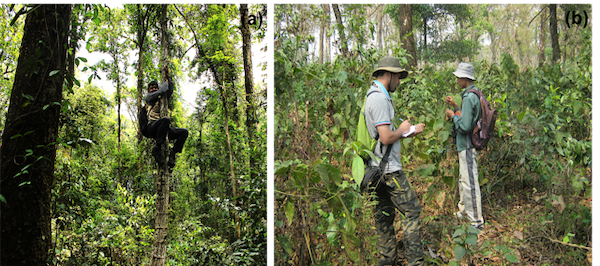Research on species diversity in the Himalayas builds partnership between UChicago and India

In his office in the Zoology building at the University of Chicago, Trevor Price, PhD, professor of ecology and evolution, keeps boxes full of old field notebooks detailing his work in the Himalayan Mountains in India. Within a few seconds of searching, he produces one from his first trip in 1977. Its pages are filled with handwritten observations, charts counting species of birds and plants, and other notes about his work in the forest. In one entry, he logged, “One and a half nets absolutely destroyed by a cow.”
Price has been working in the Himalayas for the past 40 years, traveling there for two to three months every year to study one of the world’s most diverse ecosystems. And he has encountered more than just reckless cattle. He once had to drive a graduate student with broken ribs and a head injury seven hours to the nearest hospital, only to find it closed, then another five hours to the next town. He says he fell in love with a former girlfriend after he watched her slip and fall on a glacier (“Everyone’s fallen down on a glacier at least once,” he said). His research party was even taken hostage once by guerilla fighters in Kashmir, until they escaped six days later.
During this time, Price has cemented a crucial partnership with the Wildlife Institute of India (WII), a division of the Indian government that offers training programs, academic courses and resources for wildlife research to Indian scientists. The partnership has helped him answer crucial questions about biodiversity — how and why one place has more species than another, and what happens when species migrate or disappear due to habitat loss, hunting or climate change.
“Since Darwin and Wallace, people have been trying to understand the pattern of species diversity across the world,” Price said. “Basically, that’s what ecology is. So, we've been putting a lot of time in the Himalayas trying to tease these questions apart.”

A global partnership
When Price first started working in India he was on his own, but over the years he developed friendships with conservationists, non-governmental organizations and local officials who helped him navigate bureaucracy and establish more formal working arrangements in the country’s nature reserves.
Since 2004, Price and the University of Chicago have had a formal agreement with the WII to collaborate on research, exchange students and establish visiting professorships between the two institutions. The partnership is supported by the UChicago Center in Delhi, a base for research, teaching and collaboration among scholars from the University and across India.
This arrangement continues to bear academic fruit: 10 research studies published, two UChicago postdoctoral scholars working in India, three Indian students studying in Chicago, and several professors visiting in both directions.
Among these studies is a paper published in Nature in 2014, in which Price and his Indian colleagues described the remarkable diversity of birds in the eastern Himalayas. The Himalayas have more than 460 species of songbirds — species such as wrens, swallows, finches and crows — 360 of which live in a restricted area of the eastern Himalayas. After carefully documenting and sequencing DNA of birds in this region, the researchers showed that most species were found at higher altitudes (above 2000 meters) because there is an abundance of food. Basically, it’s easier for new, varied species to fill an ecological niche there, rather than in the more competitive tropical regions at lower altitudes.
In a new study published this month in Ecology, Suresh Rana, a graduate student at the WII, and Price turned to the birds’ habitat: trees in the eastern Himalayas. Rana counted different species of trees, sampling from small plots of land at different elevations to get a good representation of all the trees in the area. He also compared their counts from the field with historical records accumulated over hundreds of years by other scientists and amateur naturalists, no doubt collected in notebooks very much like those stashed in Price’s office.

The two sets of records tell a similar story: the middle elevations between 500 and 1000 meters had the most species. This was different from the birds, which became more diverse the higher they go, but it also counters one of the biodiversity rules of thumb, that tropical regions have the most species.
Price believes this happens because of proximity and geographic constraints. The area in the middle can “receive” more new species because it sits between two distinct regions, a cooler climate at high altitudes and a warmer, wetter one as the base of the mountain. If a bird or the wind carries a seed up or down the mountain from one zone to another, most of the time nothing will happen. But if conditions are right, the seed could take root. And once trees get a foothold, they tend to last.
Chance meetings and life-changing work
Price and Rana, the lead author of the new study, literally met in the forest. Rana was working on a master’s degree on medicinal plants at the University of Jammu, and park officials told him Price was studying in the area. He went looking for Price to introduce himself and made quite the impression.
“He knew every single plant in the forest. I thought, ‘This guy is brilliant,’” Price said.
Price helped Rana get into a PhD program through the WII and continued to work with him. Their relationship mirrors Price’s mentorship of his students from UChicago, whom he encourages to follow their passions. His lab is one of only three conducting regular research on biodiversity in the Himalayas, so there are plenty of opportunities.
“There are so many projects to do there that I tend to just go with the flow of what my students want to do,” he said.
Much of the funding from the Indian government is focused elsewhere as well, supporting research on the effects of climate change in the Himalayas and creating sanctuaries to protect its tiger population. Monitoring biodiversity is largely left to academics like Price and Rana, but in spite of relatively limited resources, these more spontaneous collaborations over big questions of the natural world have blossomed.
“They certainly looked on me with suspicion when I first went there,” Price said. “They've gained quite a bit about science, and I've gained quite a bit about how to do field work in India. But I think the most important thing that has happened is we've become really good friends. It's really changed my life.”

Trevor Price, PhD
Trevor Price, PhD, is a professor in Department of Ecology & Evolution and Committee on Evolutionary Biology at UChicago. He studies the causes and consequences of the development of different species of birds, and the evolution of bird colors and color vision.
Learn more about Prof. Price